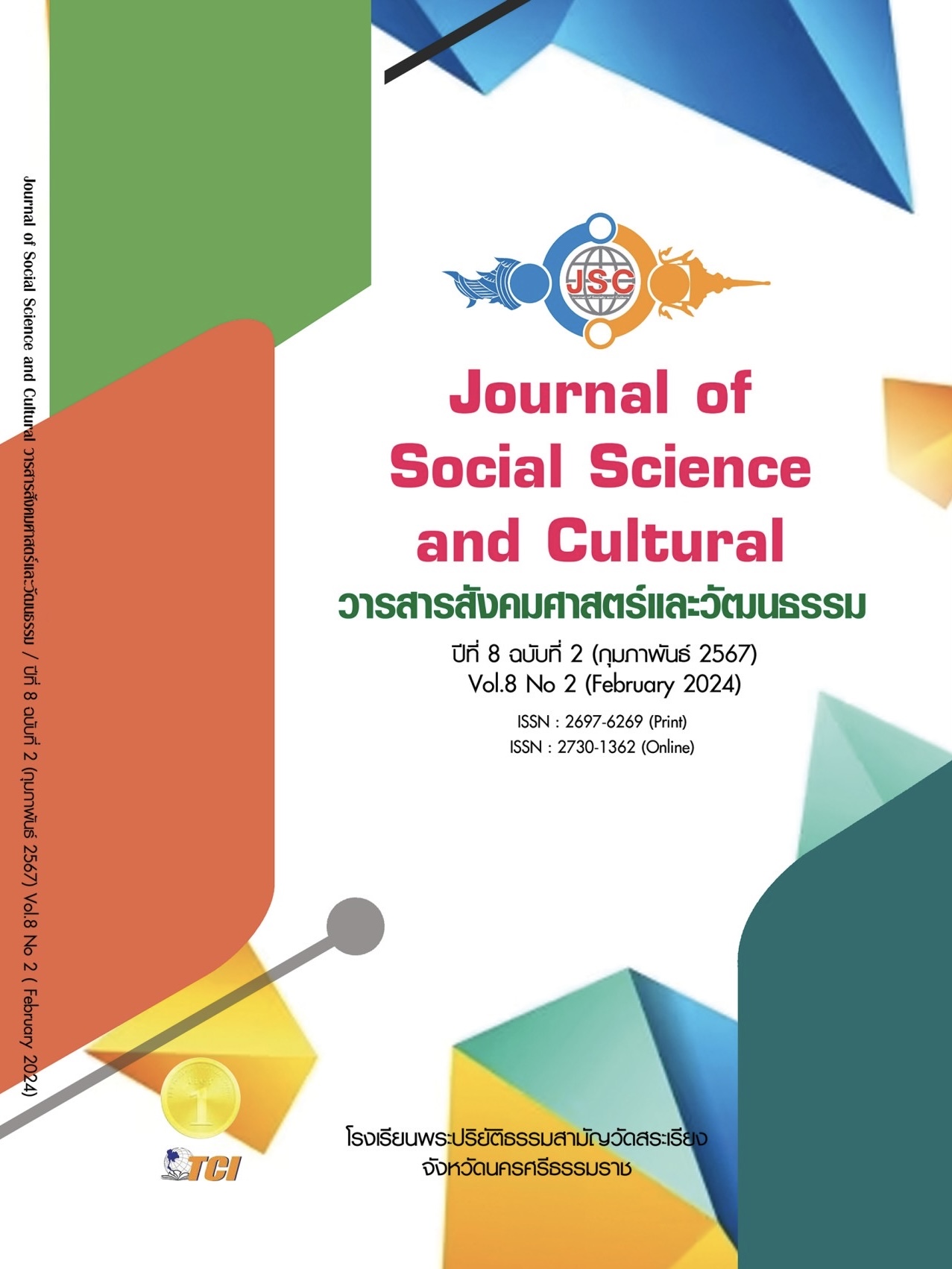THE IDENTITY OF THE KALASIN’S PEOPLE FROM KAOWONG KALASIN STICKY RICE
Main Article Content
Abstract
The main purpose of this study is to examine the identity of the people of Kalasin through Kaowong Kalasin Sticky Rice. The population under investigation resides in the Kudsimkoommai district of Kaowong Kaowong, Kalasin province. The data were gathered from five experts in Kaowong Kalasin Sticky Rice who belong to the Phu-tai ethnic group. Data collection involved in-depth interviews and focus groups. Statistical analysis for quality assessment was conducted based on the concept of identity. The findings reveal the following: 1) Kaowong Kalasin Sticky Rice defines the ethnic identity of Kalasin people through locally primed rice. 2) Kaowong Kalasin Sticky Rice, in conjunction with Prawa silk, elucidates ethnic identity, showcasing the agricultural identity rooted in the belief systems of Isan people through the depiction of the naga. 3) The identity of agriculture encapsulates Kaowong Kalasin Sticky Rice as the locally primed Gor diew rice and the photoperiod-sensitive variety, RD6, which can be cultivated in Kaowong district, parts of Kuchinarai district, and parts of Nakhu district, and should be harvested at the seed physiological maturity stage. The distinct aroma and quality of Kaowong Kalasin Sticky Rice, coupled with its Geographical Indication registration, underscore its significance as a source of income for the local community and as a representation of Kalasin’s people.
Article Details
References
กรมทรัพย์สินทางปัญญา. (2552). ทะเบียนสิ่งบ่งชี้ทางภูมิศาสตร์ของข้าวเหนียวเขาวง. กรุงเทพมหานคร: กรมทรัพย์สินทางปัญญา กระทรวงพาณิชย์.
กรมทรัพย์สินทางปัญญา. (2556). สินค้าหนึ่งจังหวัดหนึ่งสิ่งบ่งชี้ทางภูมิศาสตร์ เล่ม 1. (พิมพ์ครั้งที่ 3). กรุงเทพมหานคร: กรมทรัพย์สินทางปัญญา กระทรวงพาณิชย์.
นิระเวช นนทะมาตย์. (20 ธันวาคม 2564). การทำนาข้าวเหนียวเขาวงกาฬสินธุ์. (สุดารัตน์ มาศวรรณา, ผู้สัมภาษณ์)
ประคอง นิมมานเหมินทร์ และคณะ. (2560). คติชนคนไทยในวัฒนธรรมข้าว. กรุงเทพมหานคร: สถาบันไทยศึกษา จุฬาลงกรณ์มหาวิทยาลัย.
ประสาท พิมเภา. (20 ธันวาคม 2564). การทำนาข้าวเหนียวเขาวงกาฬสินธุ์. (สุดารัตน์ มาศวรรณา, ผู้สัมภาษณ์)
มนปพร ภูนาเมือง และสถาพร มงคลศรีสวัสดิ์. (2563). “การพัฒนาวิสาหกิจชุมชนกลุ่มเกษตรกรปลูกข้าว: กรณีศึกษากลุ่มเกษตรกรปลูกข้าวเหนียวเขาวงจังหวัดกาฬสินธุ์”. วารสารวิชาการธรรมทรรศน์, 20(3), 37-48.
วิเศษ คำไชโย. (20 ธันวาคม 2564). การทำนาข้าวเหนียวเขาวงกาฬสินธุ์. (สุดารัตน์ มาศวรรณา, ผู้สัมภาษณ์)
ศิริพร ภักดีผาสุข. (2561). ความสัมพันธ์ระหว่างภาษากับอัตลักษณ์และแนวทางการนำมาศึกษาภาษาไทย. กรุงเทพมหานคร: โรงพิมพ์แห่งจุฬาลงกรณ์มหาวิทยาลัย.
ศุภาพิชญ์ พันลำ. (20 ธันวาคม 2564). การทำนาข้าวเหนียวเขาวงกาฬสินธุ์. (สุดารัตน์ มาศวรรณา, ผู้สัมภาษณ์)
สีเมฆ ปาวะรี. (20 ธันวาคม 2564). การทำนาข้าวเหนียวเขาวงกาฬสินธุ์. (สุดารัตน์ มาศวรรณา, ผู้สัมภาษณ์)
สุเทพ ไชยขันธ์. (2558). ผู้ไทลูกแถน. กรุงเทพมหานคร: ตถาตา.
สุรสิทธิ์ สูตรสุวรรณ และการุณย์ บัวเผื่อน. (2558). “วิถีชีวิตชาวผู้ไทย ตำบลโพน อำเภอคำม่วง จังหวัดกาฬสินธุ์”. วารสารสหวิทยาการวิจัย: ฉบับบัณฑิตศึกษา, 4(2), 79-86.
อภิญญา เฟื่องฟูสกุล. (2546). อัตลักษณ์. กรุงเทพมหานคร: คณะกรรมการสภาวิจัยแห่งชาติ สาขาสังคมวิทยา สภาวิจัยแห่งชาติ.
เอี่ยม ทองดี. (2537). วัฒนธรรมข้าว: พิธีกรรมเกี่ยวกับข้าวและการทำนา. (พิมพ์ครั้งที่ 2). กรุงเทพมหานคร: สถาบันวิจัยภาษาและวัฒนธรรมเพื่อพัฒนาชนบท.
Dundes, A. (1989). Defining Indentity throgh Folklore. InFlork Mattors. Knoxville: The University Tennessee Press.


